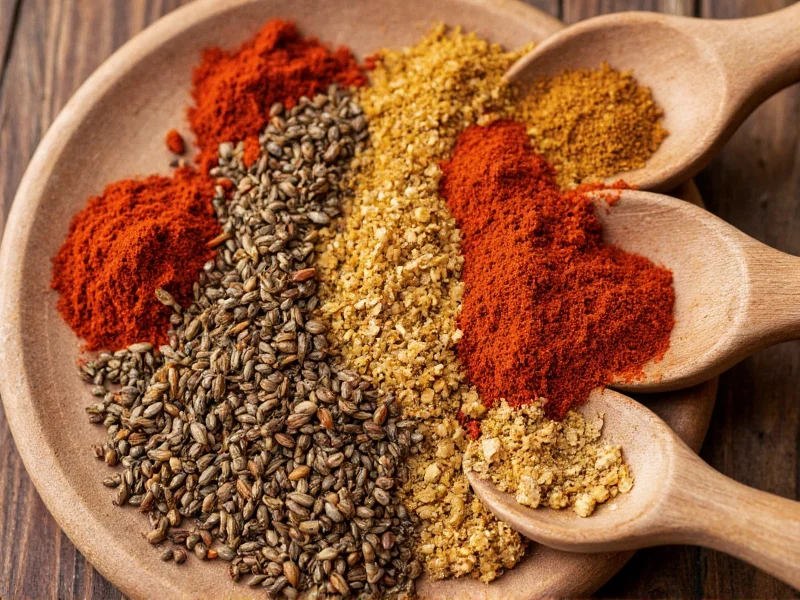Many people with celiac disease or gluten sensitivity worry about spices containing gluten, but understanding the actual risks can help you make informed choices without unnecessary restriction. While pure spices like black pepper, cinnamon, or paprika are naturally gluten-free, certain factors can introduce gluten into spice products.
How Gluten Gets Into Spice Products
Gluten doesn't occur naturally in spices, but several processing factors can lead to contamination:
| Contamination Source | How It Happens | Commonly Affected Products |
|---|---|---|
| Cross-contamination | Shared equipment with gluten-containing products | Bulk spices, spices from facilities processing wheat |
| Anti-caking agents | Some manufacturers use wheat-derived additives | Garlic powder, onion powder, curry blends |
| Spice blends | Intentional addition of wheat-based ingredients | Seasoning mixes, taco seasonings, some curry powders |
| Bulk bins | Customer contamination with gluten-containing items | Store bulk spice sections |
Spices Most Likely to Contain Gluten
While pure single-ingredient spices are gluten-free, certain products pose higher risks:
Spice Blends and Seasoning Mixes
These products most commonly contain gluten. Many commercial seasoning blends use wheat flour or starch as a filler or anti-caking agent. Common problematic blends include:
- Curry powder (some brands)
- Taco seasoning
- Some chili powder blends
- Pre-made gravy mixes
- Many "adobo" seasoning blends
Processed Spice Forms
Finely ground spices like garlic powder and onion powder have higher risk due to:
- Longer processing time increasing cross-contamination chances
- Greater surface area for potential contamination
- Common use of anti-caking agents
How to Safely Choose Gluten-Free Spices
For those with celiac disease or severe gluten sensitivity, follow these evidence-based practices:
Read Labels Carefully
Always check for these indicators:
- "Gluten-free" certification - Look for GFCO or other recognized certifications
- Ingredient list - Check for wheat, barley, rye, or malt derivatives
- "May contain" statements - Note warnings about shared equipment
Choose Reputable Brands
Some manufacturers maintain dedicated gluten-free facilities or rigorous testing protocols. Research brands known for transparency about their processing methods when determining which gluten-free spice brands to trust.
Avoid Bulk Bins
Bulk spice sections pose significant cross-contamination risks from customer handling. Even if the original container was gluten-free, shared scoops can transfer gluten from other bins. For those with severe sensitivity, how to avoid gluten in spices means steering clear of bulk options entirely.
Testing Spices for Gluten Content
While home gluten testing kits exist, they have limitations with spices:
- Spices contain natural compounds that can interfere with test results
- Most kits detect gluten at 20ppm level, but celiac-safe threshold is 20ppm or less
- Results can be inconsistent with powdered products
For accurate assessment of whether spices contain gluten, laboratory testing through services like Gluten Free Watchdog provides more reliable results than home testing kits.
Creating Your Own Safe Spice Blends
The most reliable approach for those with severe sensitivity is making your own blends:
- Purchase single-ingredient spices with gluten-free certification
- Use dedicated spice grinder (coffee grinders work well for whole spices)
- Store in clearly labeled containers away from gluten-containing products
- Create common blends like taco seasoning or curry powder from scratch
When to Contact Manufacturers
If product labeling is unclear about potential gluten exposure in spices, contact the manufacturer directly with specific questions:
- "Do you test for gluten in finished products?"
- "Are your spices processed in a dedicated gluten-free facility?"
- "What anti-caking agents do you use in your powdered spices?"
Reputable companies will provide transparent answers about their gluten control measures.
Final Considerations for Gluten-Sensitive Consumers
While the risk of gluten in pure spices is low, those with celiac disease should take reasonable precautions without unnecessary fear. Most single-ingredient spices from major brands are safe, but vigilance with blends and processed forms is warranted. Understanding cross contamination in spices helps you make informed choices rather than avoiding all spice products unnecessarily.
Do pure spices naturally contain gluten?
No, pure, single-ingredient spices like black pepper, cinnamon, or paprika do not naturally contain gluten. Gluten is a protein found in wheat, barley and rye, none of which are present in pure spice plants.
Which spices are most likely to contain gluten?
Spice blends (like taco seasoning and some curry powders) and processed spice forms (particularly garlic powder and onion powder) have the highest risk due to potential cross-contamination and added anti-caking agents.
How can I tell if my spices are gluten-free?
Look for "gluten-free" certification on the label, check ingredients for wheat derivatives, and contact manufacturers directly if unsure. Certified gluten-free products have been tested to contain less than 20ppm of gluten.
Are spices from bulk bins safe for a gluten-free diet?
Bulk spice bins generally pose significant cross-contamination risks due to shared scoops and airborne particles. For those with celiac disease, certified packaged spices are the safer option to avoid gluten in spices.
Can I trust "gluten-free" labeled spices?
Products with official gluten-free certification (like GFCO) undergo rigorous testing and are generally trustworthy. However, products with just a manufacturer's "gluten-free" claim without certification may not have been independently verified.











 浙公网安备
33010002000092号
浙公网安备
33010002000092号 浙B2-20120091-4
浙B2-20120091-4